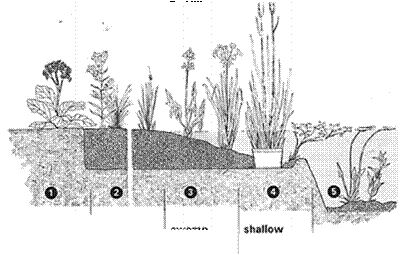 |
From at least the 1970s onwards, landscape architects in Germany have been required to use, wherever possible, native species in planting design. When wetland and water plants are to be used in the semi-natural landscape outside the urban area, as part, for example, of bioengineering works along riversides, it is important to use only appropriate native species. In an urban environment, aesthetic considerations need to be given a much higher
0 cm under water eve
8.16
Depth zones of an artificially sealed pond, adapted from a plan of the
Association of German Perennial Nurseries (BdS)
priority. In public green spaces, as in private gardens, it should be seen as important to optimise the visual effect of artificially established vegetation even when foreign plants are to be included. For example, if there is a lack of flowers in late summer or early spring, and native plants with these characteristics are not available, consideration should be given to non-invasive exotics with these species. The city landscape is, by its very nature, a human-generated environment. This is, however, a highly contentious subject. Whilst isolated ponds in designed urban and garden contexts can support both native and non-native species, the use of nonnative species should not occur alongside streams or other wetland types that may be intertconnected. Use of extremely invasive foreign species must be avoided. Examples are the East Asian Impatiens glandulifera, a wetland ruderal invading riversides in Western and Central Europe, or Lythrum salicaria from Europe, which causes major problems in nature protection in North America. Because of the reduced barriers to dispersal by seed or vegetative fragments, wetland species have a higher than average capacity to colonise native plant communities.



